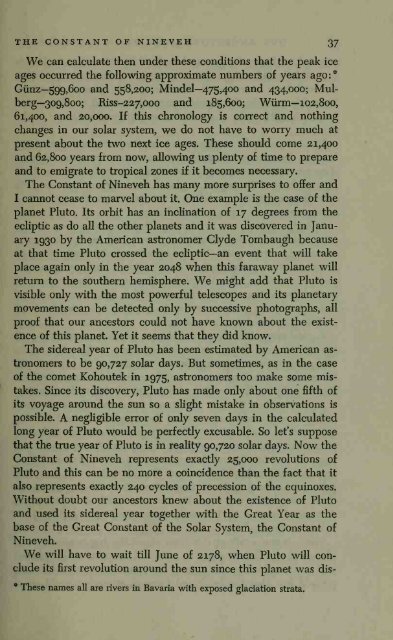Create successful ePaper yourself
Turn your PDF publications into a flip-book with our unique Google optimized e-Paper software.
THE CONSTANT OF NINEVEH 37<br />
We can calculate then under these conditions that the peak ice<br />
ages occurred the following approximate numbers of years ago:*<br />
Giinz—599,600 and 558,200; Mindel— 475,400 and 434,000; Mulberg—309,800;<br />
Riss-227,000 and 185,600; Wiirm— 102,800,<br />
61,400, and 20,000. If this chronology is correct and nothing<br />
changes in our solar system, we do not have to worry much at<br />
present about the two next ice ages. These should come 21,400<br />
and 62,800 years from now, allowing us plenty of time to prepare<br />
and to emigrate to tropical zones if it becomes necessary.<br />
The Constant of Nineveh has many more surprises to offer and<br />
I cannot cease to marvel about it. One example is the case of the<br />
planet Pluto. Its orbit has an inclination of 17 degrees from the<br />
ecliptic as do all the other planets and it was discovered in January<br />
1930 by the American astronomer Clyde Tombaugh because<br />
at that time Pluto crossed the ecliptic—an event that will<br />
take<br />
place again only in the year 2048 when this faraway planet will<br />
return to the southern hemisphere. We might add that Pluto is<br />
visible only with the most powerful telescopes and its planetary<br />
movements can be detected only by successive photographs, all<br />
proof that our ancestors could not have known about the existence<br />
of this planet. Yet it seems that they did know.<br />
The sidereal year of Pluto has been estimated by American astronomers<br />
to be 90,727 solar days. But sometimes, as in the case<br />
of the comet Kohoutek in 1975, astronomers too make some mistakes.<br />
Since its discovery, Pluto has made only about one fifth of<br />
its<br />
voyage around the sun so a slight mistake in observations is<br />
possible. A negligible error of only seven days in the calculated<br />
long year of Pluto would be perfectly excusable. So let's suppose<br />
that the true year of Pluto is in reality 90,720 solar days. Now the<br />
Constant of Nineveh represents exactly 25,000 revolutions of<br />
Pluto and this can be no more a coincidence than the fact that it<br />
also represents exactly 240 cycles of precession of the equinoxes.<br />
Without doubt our ancestors knew about the existence of Pluto<br />
and used its sidereal year together with the Great Year as the<br />
base of the Great Constant of the Solar System, the Constant of<br />
Nineveh.<br />
We will have to wait till June of 2178, when Pluto will conclude<br />
its first revolution around the sun since this planet was dis-<br />
* These names all are rivers in Bavaria with exposed glaciation strata.

















